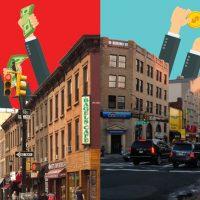College-educated yuppies fanning out to low-income communities in a search for affordable housing has become a major point of tension in New York City.
But as investment follows, it has raised a question: Is gentrification a blessing or a curse?
The answer is, it depends. The nuances were explored on Wednesday’s edition of TRD Talks Live by Bronx Community Board 6 district manager John Sanchez and the Manhattan Institute’s Kay Hymowitz.
Sanchez said efforts to improve neighborhoods seem to come only when gentrification does.
Read more



“I’m never going to cast blame or cast shame on someone that wants to live in the Bronx because it’s the only place they can live in,” Sanchez said. “The frustration from a lot of communities of color is that once so-called gentrifiers come in, then the investment comes.”
Hymowitz, the William E. Simon fellow at her free-market think tank, raised a different point.
“Another way to think about gentrification, at least in many cases, is integration,” she noted.
The conversation revolves around whether gentrification causes displacement, a subject of research by economists and a major motivator of opposition to New York real estate projects.
An often-cited study by Churches United for Fair Housing tracked demographic changes following the Greenpoint/Williamsburg waterfront rezoning in 2005 and the Park Slope/4th Avenue rezoning in 2003. It shows the Black and Latino populations fell in both areas over more than a decade beginning in 2000, despite increasing in the city as a whole.
However, another study, by the National Bureau of Economic Research, found gentrification did not supercharge displacement of individuals. Using Medicaid records to track the paths of children living in New York City from January 2009 to December 2015, it showed that low-income families move often, even in non-gentrifying neighborhoods.
The difference is that in gentrifying neighborhoods, those families are more likely to be replaced by residents who are wealthier and white.
“A lot of people have an image, when you talk about displacement, of eviction, people who are being forced out by landlords,” said Hymowitz.
Advocates for development have said more housing construction in gentrifying areas would absorb newcomers, reducing displacement and curb rents. At the same time, others have emphasized that adding apartments in high-income areas would allow others to enjoy their advantages and ease gentrification elsewhere.
Sanchez, a candidate for City Council in the Bronx, argued for increasing housing in all neighborhoods. In a recent op-ed for Gotham Gazette, he wrote that restrictive zoning in areas like Soho and Riverdale prevents mixed-income housing, which would allow more minorities to reap the benefits of living in those areas.
“We shouldn’t be limiting homes, we shouldn’t be limiting the amount of people that can live in our city, we shouldn’t be limiting our tax base,” Sanchez said. “And that’s my approach to land use. Housing is a basic need.”
Contact Sasha Jones at sasha.jones@therealdeal.com